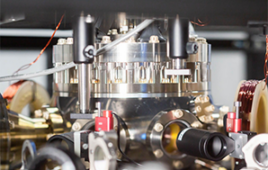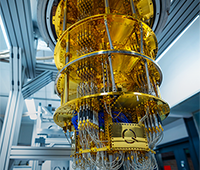Laptops Send Early Earthquake Warnings
A simple idea for monitoring earthquakes with help from the public is now being realized. Called “Quake-Catcher Network,” the project involves distributed
 |
computing, a method in which different parts of a computer program run simultaneously on two or more computers that are in communication with a central server over a network. Anyone with a personal computer will be able to participate when linking software is publicly released later this year on boinc.berkeley.edu. Elizabeth Cochran, a seismologist at UC Riverside, came up with the idea to make use of inexpensive motion sensors, called accelerometers, which are already in place as safety devices in most new laptops.
“We’re turning the laptops’ accelerometers into earthquake monitors,” said Cochran. “With a dense grid of detectors in place, an early warning can be sent through the Internet to neighboring cities should an earthquake strike, giving people up to 10-20 seconds to prepare themselves before the seismic waves reach them.”
Already, about 300 people spread around the world are taking part in the Quake-Catcher Network, with roughly a third of the participants in the United States.
“The idea is to fill in the spaces – or holes – in the seismic network currently being used to report earthquakes,” Cochran said. “With the public’s participation in Quake-Catcher Network, however, we can have a lot more ‘stations’ recording earthquakes, allowing for a better early warning system. At present in California, no such early warning system for earthquakes exists.”
Currently, approximately 350 stations monitor earthquakes in Southern California using underground sensors. They do so, however, not in real time.
“There is a delay of 10-15 seconds from when the sensors record an earthquake to when the data is processed at either Caltech in Southern California or UC Berkeley in Northern California,” Cochran explained. “Quake-Catcher Network would process data in real time, as it comes in. And the network can stretch out to any region of the world. Besides being inexpensive, it makes an extremely small demand on CPU resources.”
According to Cochran, a person’s laptop needs to remain inactive for at least three minutes before the system starts up. “This is to get rid of noise in the data and to ensure that any movement the laptop’s accelerometer is detecting is indeed out of the ordinary,” she said.
Currently, only Apple computers can participate in the project, but Cochran and her colleagues are working on including other computers in Quake-Catcher Network.
“We also are working on developing an accelerometer which can be plugged into a desktop like a USB flash drive,” she said. “That way, we’d have less interference from typing on the keyboard. It also would allow for a more robust and reliable system, with computers running the software all of the time.”
Cochran said she plans to make all the data gathered by the sensors freely available to researchers and the public.
“This data can be used to study how a seismic wave propagates in the ground,” she said. “How fast a wave travels can give us useful information, such as more details on seismic hazard as well as the structure of the Earth. The denser our network, the clearer will be the picture of what is happening at each step in time. A series of such pictures could be used to develop a movie showing the wave’s propagation, which could give us extremely useful information about seismic waves.”



